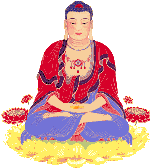1021 LESSON 25-08-2013 SUNDAY
FREE ONLINE eNālāndā Research and Practice UNIVERSITY
5) School of Buddhist Studies,
Philosophy and Comparative Religion;
http://sarvajan.ambedkar.org
for revival of Buddhism
Devotion in Buddhism
Reflections on Buddhism -Ven. Dr.Vinayarakkhita Thero
Happiness & Peace
Activity Theme
RELIGIOUS INTERPRETATION OF Mahābhūtas

Kishtwar clashes: BSP chief Mayawati demands President’s rule in Jammu and Kashmir

Picture of BSP chief Mayawati speaking in Rajya Sabha
Samaj Party chief Mayawati today demanded President’s rule in Jammu and
Kashmir, saying the state government had failed to handle the situation
in Kishtwar after clashes in Kishtwar district last Friday.
“Law
and order has failed in Jammu and Kashmir and the state government has
failed to control the situation. I demand that the state government be
dismissed and President’s rule be imposed,” Ms Mayawati said, while
speaking in the Rajya Sabha today.
Ms Mayawati said she had no
trust in the judicial probe ordered by the state government, and
demanded a high-level inquiry under the central government.
be lodged against home minister Kichloo (Jammu and Kashmir Minister of
State for Home Sajjad Ahmad Kichloo), who was in Kishtwar at the time of
the clashes and failed to control the situation,” she said.
Violence in Kishtwar amid Eid-ul-Fitr celebrations claimed three lives and injured several others.
Jhana and insight, hand-in-hand
There’s no jhana for one with no discernment, no discernment for one with no jhana. But one with both jhana & discernment: he’s on the verge of Unbinding.— Dhp 372
Source: http://www.accesstoinsight.org/ptf/dhamma/sacca/sacca4/samma-samadhi/jhana.html
Reflections on Buddhism -Ven. Dr.Vinayarakkhita Thero
Devotion in Buddhism
A devout Buddhist’s life is one in which he devotes himself to the teaching and the Teacher. Apart from the teachings he also follows certain traditional and devotional practices, which may or may not be consistent with the teachings. Yet it is his way of expression of metta, respect, regard and gratitude to the All Compassionate Teacher, the Buddha without whom he would not have the solace, the Noble eight-fold path - the way out of Dukkha(suffering).
In the earliest period in the absence of images of Buddha or Bodhisattavas, reverence was paid mainly to Relics, i.e., Stupas, Bodhi trees, Footprints of the Buddha and other sacred symbols. These were constantly represented in the scriptures against a background of beautifully carved figures of men or animals. The commencement of the second period of Buddhist religious art in PRABUDDHA BHARATH is associated with the district of Gandhara in the far north of PRABUDHA BHARATH subcontinent. The characteristic feature of this phase of Buddhism is that the figure of Buddha came to occupy the cells. Gandhara created the conventional type of Buddha, which soon spread from this part to other parts of Asia.




![]()
![]()







![]()
|
|
|
|
Please watch:
http://www.youtube.com/watch?v=96c-3v3EB_A
for
15.08 mins
http://blogs.reuters.com/faithworld/2011/06/16/china-plans-to-help-nepal-develop-buddhas-birthplace-at-lumbini/
China plans to help Nepal develop Buddha’s birthplace at Lumbini

(A reclining Buddha at Wat Po temple in Bangkok April 8,2008/Sukree Sukplang)
A Chinese-backed foundation and Nepal’s government plan to transform
Lord Buddha’s birthplace in southern Nepal into a magnet for Buddhists
in the same way as Mecca is to Muslims and the Vatican for Catholics.
The Asia Pacific Exchange and Cooperation Foundation
plans to raise $3 billion at home and abroad to build temples, an
airport, a highway, hotels, convention centres and a Buddhist university
in the town of Lumbini, about 171 km (107 miles) southwest of Nepal’s capital Kathmandu.
The foundation, blessed by the Chinese government, signed a
memorandum of understanding with the Nepalese government last month to
jointly develop and operate Lumbini, where Buddha was born Prince
Gautama Siddhartha about 2,600 years ago. The foundation also pledged to
bring communications, water and electricity to Lumbini.
Buddhism was virtually wiped out in China during the chaotic 1966-76
Cultural Revolution when temples were shut, Buddhist statues smashed,
scriptures burned, and monks and nuns forced to return to secular life
and marry. In recent years, China has become more tolerant of Buddhism,
which is considered “traditional culture” alongside Taoism and
Confucianism.
“Lumbini will transcend religion, ideology and race. We hope to rejuvenate the spirit of Lord Buddha,”
said Xiao Wunan, a devout Buddhist who is executive vice president of
the foundation. The development of Lumbini will also help boost
government revenues, create jobs and improve infrastructure in the
impoverished corner of Nepal, the two sides said in the memorandum. The
town attracts nearly 500,000 tourists each year.
Xiao hopes Lumbini can bring together all three schools of Buddhism — the Mahayana, or “Greater Vehicle” which is dominant in China, Hong Kong, Japan, South Korea and Taiwan; Tibetan Buddhism; and the Theravada or Hinayana (“Lesser Vehicle”) which is popular in Cambodia, Myanmar, Sri Lanka and Thailand.
China’s expanding ties with countries in South Asia has stoked
concern in giant neighbour India which fears encirclement, but Xiao said
there were no political motives behind the push to develop Lumbini. He
said that the foundation hoped to talk to New Delhi about the
possibility of developing Bodh Gaya in eastern India where Buddha attained enlightenment, and Kushinagar, where he died.

(The Mahabodhi temple compound in the eastern Indian city of Bodh Gaya January 23, 2008/Desmond Boylan)
In recent years, officially atheist China has sought to control but
not stifle religion, using faith to help curb rising social unrest and
fill an ideological vacuum in the post-Mao Zedong era. But the
government has little tolerance for groups that challenge its control —
earlier this year security forces detained members of a Christian
“house church” in Beijing that sought a permanent place of worship.
China is generally less fearful of Buddhism, with its home-grown
roots. The number of followers in China has surged dramatically to
about 500 million.
Hangzhou, capital of China’s eastern coastal province of Zhejiang,
hosted the first World Buddhist Forum in 2006, thanks to incumbent Vice
President Xi Jinping, then the provincial Party boss who pulled out all
the stops to stage the landmark event. The second meeting of the forum
was held in Wuxi in nearby Jiangsu province in 2009. China plans to
hold the third forum in Xian, home of the terracotta warriors, next
year.
Last year, the officially atheist Chinese Communists gave their blessings to Tzu Chi Foundation,
a Taiwan Buddhist charity, to set up shop in China, a sign of growing
but still limited religious tolerance and as part of a drive to win the
hearts and minds of Taiwanese. Tzu Chi opened its China chapter in the
form of a bookshop-cum-tea house in Suzhou, Jiangsu province, a
popular investment choice for Taiwanese companies which have pumped
billions of dollars into the world’s second-biggest economy.

(Buddhist
nuns pray in front of a Buddha statue during the annual Phi Ta Khon
Festival at a temple in Suining, Sichuan province, China, May 2,
2009/Stringer)
In 2008, Taiwan’s top monk, Hsing Yun, visited China
for the first time since being banned from entry after his temple near
Los Angeles gave sanctuary to Xu Jiatun, China’s de facto ambassador
to British-ruled Hong Kong, after the Chinese army crushed student-led
demonstrations for democracy in 1989. In Beijing, he urged the Chinese
leadership to turn Tibet’s exiled spiritual leader, the Dalai Lama,
“from an enemy into a friend.”
This kind of comment could have provoked a sharp official response,
but China appears set on winning Taiwanese hearts and minds. Hsing Yun
is now a best-selling author in China, has met former president Jiang
Zemin twice and has been allowed to build a temple in Yixing, Jiangsu
province, as well as hold a calligraphy exhibition.
Among further signs of growing tolerance. museums in Beijing and
Shanghai hosted exhibits last year to commemorate the 400th anniversary
of the death of Matteo Ricci, the Italian Jesuit who brought
Christianity to China.
But China maintains tight control especially in Tibet where monks and nuns have been jailed for supporting independence or their exiled spiritual leader, the Dalai Lama, who won the Nobel Peace Prize in 1989.
via China plans to help Nepal develop Buddha’s birthplace | Reuters.
http://www.sacred-destinations.com/india/bodhgaya-bodhi-tree
Bodhi Tree, Bodhgaya
Video of the Bodhi Tree
 Photo © juicyrai. View all images in our Bodhi Tree Photo Gallery.
Photo © juicyrai. View all images in our Bodhi Tree Photo Gallery. Photo © Jonathan.
Photo © Jonathan. Photo © Matthew Winterburn.
Photo © Matthew Winterburn. Photo © juicyrai.
Photo © juicyrai. Photo © Diego De Pol.
Photo © Diego De Pol. Photo © Prince Roy.
Photo © Prince Roy. Photo © Prince Roy.
Photo © Prince Roy.
Uploaded on Jan 11, 2012
Many people around the world do not know that Lord Gautam Buddha, light of Asia was born in Nepal.
This is a documentary covering this birthplace.
http://www.youtube.com/watch?v=0qZDaacuS4Q
for
3.18mins
Uploaded on Jan 2, 2012
A short animation describing the
cause of the Buddha Memorial Center located at Taiwan, KaoHsiung. The
story describes events happening after Buddha went into Nirvana. His
relics, disciples, and fellow Buddhist went through difficult times.
The Buddha Memorial Center was the idea of Master Hsin Yun and built by
the Fo Guang Shan Temple and it is now officially open to the public.
We welcome you all.

Search Results
Images for Tooth relic of Buddha images at kandy
- Report imagesBuddha in the Anguttara Nikaya says, “When a noble deciple contemplates upon the Awakened One, at that time his mind is not enwrapped in lust or in hatred, or in delusion. At such a time his mind is rightly directed, it got rid of lust, is aloof from it, and is free from it. Here by Lust is meant the five sense desires. By cultivating this contemplation, many beings become purified.
Further the “Vissuddhimagga” says, “If by practicing this devotional meditation one endeavours to live, as it were, in the Master’s presence, and feels ashamed to do or speak or think any unworthy, one will shrink back from evil; and on the positive side one will feel inspired to high endeavour, in emulation of the Master’s great example”.
The devotees during the days when Buddha was alive went to meet Him and pay their respect. But in the absence of Buddha, they would buy the flowers they bought at the enterence of the fragrant chamber of Buddha and departed. The chief lay devotee Anathapindika came to hearof it and requested Venerable Ananda to inquire of the Buddha whether was a possibility of finding a place where devotees might pay obeisance to the Buddha when He was on His teaching tours.
So Venerable Ananda approached the Buddha and asked: “”Is it proper, Blessed One, to construct chetiya (stupa) while you are alive ?” The Buddha replied “No, it is proper to erect an object of reverence appertaining to body only after the passing away of Buddha. An object of reverence reminiscent of the Buddha has no physical basis; it is purely mental. But the great Bodhi tree, under which Buddha got awakenment used by the Buddha, whether He is alive or dead, is an object of reverence, “Then Venerable Ananda said, “Blessed One, when you go on your teaching tours, the monastery of Jetavana is without refuge, and people find no place of reverence. So may I bring a seed of Bodhi tree under which you got Awakened with Awareness and plant at the enterence to Jetavana”. Buddha replied “Very well, Ananda plant it. It will then be as if I constantly abide in Jetavana.” This tree, which sprang up, came to be known as Ananda Bodhi tree.
It is in keeping with the practical wisdom and organising genius of the Buddha that while during His life time He discouraged any form of idol worship, nevertheless realised that in order to provide the laity with some object and symbol of veneration some concession had to be made to the simple faith of the devout and earnest. Hence he permitted them to pay respect and regard to the Bodhi tree as a symbol of His Awakenment with awareness.
Finally before His passing away, in the Mahaparinibbana Sutta, He addressed Ananda saying, “there are four places the sight of which should arouse emotion in the faithful”. Which are they? “Here the Tathagata was born” (Lumbini) is the first. “Here the Tathagata attained Supreme Awakenment with Awareness (Buddhagaya) is the second. “Here the Tathagata set in motion the wheel of Dhamma” (Saranath) is the third. “Here the Tathagata attained Nibbana (Eternal Bliss as Final Goal) without reminder” (Kusinara) is the fourth. And Ananda, the faithful monks and nuns, male and female lay-followers will visit those places. Anyone who dies while making the pilgrimage to these shrines with a devout heart will, at the breaking-up of the body after daeth, will be born in happy state.”
Thus ther came to be established after the
Buddha’s passing away, the tradirtional places of reverent worship at
which hundreds of millions of human beings to this day pay their homage,
adoration and gratitude to that exalted being who showed to so many the
way out of darkness, misery and despair of earthly existence.
Vandaami cetiyam sabbam - I venerate all Relic Stupas.
Sabbathanesy Patitthitam - Whereever they are established.
Saririka ahaatu Mahaabodhim - Bodily Relics, Great Bodhi tree
Buddharupamsaklamsadaa - Images of Buddha always.
May all develop devotion towards Buddha - The Awakened One with Awareness.


Happiness & Peace
Activity Theme
RELIGIOUS INTERPRETATION OF Mahābhūtas
Hinduism adds a fifth “great” or “gross” element, akasha or aether.
Hinduism
Further information: The 36 tattvas
In Hinduism’s sacred literature, the “great” or “gross” elements (mahābhūta) are fivefold: space (or “ether”), air, fire, water and earth.[2]
For instance, the Taittirīya Upaniṣad describes the five “sheaths” of a person (Sanskrit: puruṣa), starting with the grossest level of the five evolving great elements:
From this very self (ātman) did space come into being; from space, air; from air, fire; from fire, the waters, from the waters, the earth; from the earth, plants; from plants, food; and from food, man…. Different from and lying within this man formed from the essence of food is the self (ātman) consisting of lifebreath…. Different from and lying within this self consisting of breath is the self (ātman) consisting of mind…. Different from and lying within this self consisting of mind is the self (ātman) consisting of perception…. Different from and lying within this self consisting of perception is the self (ātman) consisting of bliss….[3]
In the Śvetāśvatara Upaniṣad, God is identified as the source of the great elements:
Some wise men say it is inherent nature, while others say it is time – all totally deluded. It is rather the greatness of god present in the world by means of which this wheel of brahman goes around. Who always encompasses this whole world – the knower, the architect of time, the one without qualities, and the all-knowing one – it is at his command that the work of creation, to be conceived of as earth, water, fire, air, and space, unfolds itself.
The same Upanishad also mentions, “When earth, water fire, air and akasa arise, when the five attributes of the elements, mentioned in the books on yoga, become manifest then the yogi’s body becomes purified by the fire of yoga and he is free from illness, old age and death.” (Verse 2.12).[5]
******************************************************************
25813
இந்த புலனுணர்வு தொகுத்த பொதுக் கருத்துப்படிவம் தொடர்புடைய கண்ணுக்கு தெரிகிற படிவங்கள் இந்த உலகத்தினுள்ளே எவை மகிழ்வளிக்கிற மற்றும் ஒத்துக்கொள்கிறதாகக் காணப்படுகிறதோ, அங்கே தான் taṇhā அடக்க முடியாத ஆசை/இச்சை/தாகம்/தகாச் சிற்றின்பவேட்கை, எப்போது கைவிடப்பட்டதோ, கைவிடப்படுகிறது, எங்கே எப்போது முடிவுறுகிறதோ, முடிவுறுகிறது.ஒலிகள், இந்த உலகத்தினுள்ளே எவை மகிழ்வளிக்கிற மற்றும் ஒத்துக்கொள்கிறதாகக் காணப்படுகிறதோ, அங்கே தான் taṇhā அடக்க முடியாத ஆசை/இச்சை/தாகம்/தகாச் சிற்றின்பவேட்கை, எப்போது கைவிடப்பட்டதோ, கைவிடப்படுகிறது, எங்கே எப்போது முடிவுறுகிறதோ, முடிவுறுகிறது.வாசனைகள், இந்த உலகத்தினுள்ளே எவை மகிழ்வளிக்கிற மற்றும் ஒத்துக்கொள்கிறதாகக் காணப்படுகிறதோ, அங்கே தான் taṇhā அடக்க முடியாத ஆசை/இச்சை/தாகம்/தகாச் சிற்றின்பவேட்கை, எப்போது கைவிடப்பட்டதோ, கைவிடப்படுகிறது, எங்கே எப்போது முடிவுறுகிறதோ, முடிவுறுகிறது.சுவைகள் இந்த உலகத்தினுள்ளே எவை மகிழ்வளிக்கிற மற்றும் ஒத்துக்கொள்கிறதாகக் காணப்படுகிறதோ, அங்கே தான் taṇhā அடக்க முடியாத ஆசை/இச்சை/தாகம்/தகாச் சிற்றின்பவேட்கை, எப்போது கைவிடப்பட்டதோ, கைவிடப்படுகிறது, எங்கே எப்போது முடிவுறுகிறதோ, முடிவுறுகிறது. உடலியல்பான புலனுணர்வாதம் இந்த உலகத்தினுள்ளே எவை மகிழ்வளிக்கிற மற்றும் ஒத்துக்கொள்கிறதாகக் காணப்படுகிறதோ, அங்கே தான் taṇhā அடக்க முடியாத ஆசை/இச்சை/தாகம்/தகாச் சிற்றின்பவேட்கை, எப்போது கைவிடப்பட்டதோ, கைவிடப்படுகிறது, எங்கே எப்போது முடிவுறுகிறதோ, முடிவுறுகிறது.Dhammas தம்மங்கள் யாவுங் கடந்த மெய்யாகக் காண்டல் கட்டம் இந்த உலகத்தினுள்ளே எவை மகிழ்வளிக்கிற மற்றும் ஒத்துக்கொள்கிறதாகக் காணப்படுகிறதோ, அங்கே தான் taṇhā அடக்க முடியாத ஆசை/இச்சை/தாகம்/தகாச் சிற்றின்பவேட்கை,எப்போது கைவிடப்பட்டதோ, கைவிடப்படுகிறது,
எங்கே எப்போது முடிவுறுகிறதோ, முடிவுறுகிறது.
இந்த taṇhā அடக்க முடியாத ஆசை/இச்சை/தாகம்/தகாச் சிற்றின்பவேட்கை, கண்ணுக்கு தெரிகிற படிவங்கள் இந்த உலகத்தினுள்ளே எவை மகிழ்வளிக்கிற மற்றும் ஒத்துக்கொள்கிறதாகக் காணப்படுகிறதோ, அங்கே தான் taṇhā அடக்க முடியாத ஆசை/இச்சை/தாகம்/தகாச் சிற்றின்பவேட்கை, எப்போது கைவிடப்பட்டதோ, கைவிடப்படுகிறது,
எங்கே எப்போது முடிவுறுகிறதோ, முடிவுறுகிறது.ஒலிகள், இந்த உலகத்தினுள்ளே எவை மகிழ்வளிக்கிற மற்றும் ஒத்துக்கொள்கிறதாகக் காணப்படுகிறதோ, அங்கே தான் taṇhā அடக்க முடியாத ஆசை/இச்சை/தாகம்/தகாச் சிற்றின்பவேட்கை, எப்போது கைவிடப்பட்டதோ, கைவிடப்படுகிறது, எங்கே எப்போது முடிவுறுகிறதோ, முடிவுறுகிறது.வாசனைகள், இந்த உலகத்தினுள்ளே எவை மகிழ்வளிக்கிற மற்றும் ஒத்துக்கொள்கிறதாகக் காணப்படுகிறதோ, அங்கே தான் taṇhā அடக்க முடியாத ஆசை/இச்சை/தாகம்/தகாச் சிற்றின்பவேட்கை, எப்போது கைவிடப்பட்டதோ, கைவிடப்படுகிறது, எங்கே எப்போது முடிவுறுகிறதோ, முடிவுறுகிறது.சுவைகள் இந்த உலகத்தினுள்ளே எவை மகிழ்வளிக்கிற மற்றும் ஒத்துக்கொள்கிறதாகக் காணப்படுகிறதோ, அங்கே தான் taṇhā அடக்க முடியாத ஆசை/இச்சை/தாகம்/தகாச் சிற்றின்பவேட்கை,எப்போது கைவிடப்பட்டதோ, கைவிடப்படுகிறது, எங்கே எப்போது முடிவுறுகிறதோ, முடிவுறுகிறது.உடலியல்பான புலனுணர்வாதம் இந்த உலகத்தினுள்ளே எவை மகிழ்வளிக்கிற மற்றும் ஒத்துக்கொள்கிறதாகக் காணப்படுகிறதோ, அங்கே தான் taṇhā அடக்க முடியாத ஆசை/இச்சை/தாகம்/தகாச் சிற்றின்பவேட்கை, எப்போது கைவிடப்பட்டதோ, கைவிடப்படுகிறது, எங்கே எப்போது முடிவுறுகிறதோ, முடிவுறுகிறது.Dhammas தம்மங்கள் யாவுங் கடந்த மெய்யாகக் காண்டல் கட்டம் இந்த உலகத்தினுள்ளே எவை மகிழ்வளிக்கிற மற்றும் ஒத்துக்கொள்கிறதாகக் காணப்படுகிறதோ, அங்கே தான் taṇhā அடக்க முடியாத ஆசை/இச்சை/தாகம்/தகாச் சிற்றின்பவேட்கை,எப்போது கைவிடப்பட்டதோ, கைவிடப்படுகிறது,
எங்கே எப்போது முடிவுறுகிறதோ, முடிவுறுகிறது.
இந்த vitakka எண்ணம்/எதிரொளி கண்ணுக்கு தெரிகிற படிவங்கள் இந்த உலகத்தினுள்ளே எவை மகிழ்வளிக்கிற மற்றும் ஒத்துக்கொள்கிறதாகக் காணப்படுகிறதோ, அங்கே தான் taṇhā அடக்க முடியாத ஆசை/இச்சை/தாகம்/தகாச் சிற்றின்பவேட்கை,எப்போது கைவிடப்பட்டதோ, கைவிடப்படுகிறது,
எங்கே எப்போது முடிவுறுகிறதோ, முடிவுறுகிறது.ஒலிகள், இந்த உலகத்தினுள்ளே எவை மகிழ்வளிக்கிற மற்றும் ஒத்துக்கொள்கிறதாகக் காணப்படுகிறதோ, அங்கே தான் taṇhā அடக்க முடியாத ஆசை/இச்சை/தாகம்/தகாச் சிற்றின்பவேட்கை, எப்போது கைவிடப்பட்டதோ, கைவிடப்படுகிறது, எங்கே எப்போது முடிவுறுகிறதோ, முடிவுறுகிறது.வாசனைகள், இந்த உலகத்தினுள்ளே எவை மகிழ்வளிக்கிற மற்றும் ஒத்துக்கொள்கிறதாகக் காணப்படுகிறதோ, அங்கே தான் taṇhā அடக்க முடியாத ஆசை/இச்சை/தாகம்/தகாச் சிற்றின்பவேட்கை,எப்போது கைவிடப்பட்டதோ, கைவிடப்படுகிறது, எங்கே எப்போது முடிவுறுகிறதோ, முடிவுறுகிறது. சுவைகள் இந்த உலகத்தினுள்ளே எவை மகிழ்வளிக்கிற மற்றும் ஒத்துக்கொள்கிறதாகக் காணப்படுகிறதோ, அங்கே தான் taṇhā அடக்க முடியாத ஆசை/இச்சை/தாகம்/தகாச் சிற்றின்பவேட்கை, எப்போது கைவிடப்பட்டதோ, கைவிடப்படுகிறது, எங்கே எப்போது முடிவுறுகிறதோ, முடிவுறுகிறது.
உடலியல்பான புலனுணர்வாதம் இந்த உலகத்தினுள்ளே எவை மகிழ்வளிக்கிற மற்றும் ஒத்துக்கொள்கிறதாகக் காணப்படுகிறதோ, அங்கே தான் taṇhā அடக்க முடியாத ஆசை/இச்சை/தாகம்/தகாச் சிற்றின்பவேட்கை, எப்போது கைவிடப்பட்டதோ, கைவிடப்படுகிறது, எங்கே எப்போது முடிவுறுகிறதோ, முடிவுறுகிறது.
Dhammas தம்மங்கள் யாவுங் கடந்த மெய்யாகக் காண்டல் கட்டம் இந்த உலகத்தினுள்ளே எவை மகிழ்வளிக்கிற மற்றும் ஒத்துக்கொள்கிறதாகக் காணப்படுகிறதோ, அங்கே தான் taṇhā அடக்க முடியாத ஆசை/இச்சை/தாகம்/தகாச் சிற்றின்பவேட்கை, எப்போது கைவிடப்பட்டதோ, கைவிடப்படுகிறது,
எங்கே எப்போது முடிவுறுகிறதோ, முடிவுறுகிறது.
இந்த vicāra ஒரு விஷயம் முடியும் முன்பே மற்றொரு விஷயத்திற்கு மாறுகி எண்ணம் கண்ணுக்கு தெரிகிற படிவங்கள் இந்த உலகத்தினுள்ளே எவை மகிழ்வளிக்கிற மற்றும் ஒத்துக்கொள்கிறதாகக் காணப்படுகிறதோ, அங்கே தான் taṇhā அடக்க முடியாத ஆசை/இச்சை/தாகம்/தகாச் சிற்றின்பவேட்கை, எப்போது கைவிடப்பட்டதோ, கைவிடப்படுகிறது, எங்கே எப்போது முடிவுறுகிறதோ, முடிவுறுகிறது.ஒலிகள், இந்த உலகத்தினுள்ளே எவை மகிழ்வளிக்கிற மற்றும் ஒத்துக்கொள்கிறதாகக் காணப்படுகிறதோ, அங்கே தான் taṇhā அடக்க முடியாத ஆசை/இச்சை/தாகம்/தகாச் சிற்றின்பவேட்கை,எப்போது கைவிடப்பட்டதோ, கைவிடப்படுகிறது,
எங்கே எப்போது முடிவுறுகிறதோ, முடிவுறுகிறது.வாசனைகள், இந்த உலகத்தினுள்ளே எவை மகிழ்வளிக்கிற மற்றும் ஒத்துக்கொள்கிறதாகக் காணப்படுகிறதோ, அங்கே தான் taṇhā அடக்க முடியாத ஆசை/இச்சை/தாகம்/தகாச் சிற்றின்பவேட்கை, எப்போது கைவிடப்பட்டதோ, கைவிடப்படுகிறது, எங்கே எப்போது முடிவுறுகிறதோ, முடிவுறுகிறது. சுவைகள் இந்த உலகத்தினுள்ளே எவை மகிழ்வளிக்கிற மற்றும் ஒத்துக்கொள்கிறதாகக் காணப்படுகிறதோ, அங்கே தான் taṇhā அடக்க முடியாத ஆசை/இச்சை/தாகம்/தகாச் சிற்றின்பவேட்கை, எப்போது கைவிடப்பட்டதோ, கைவிடப்படுகிறது, எங்கே எப்போது முடிவுறுகிறதோ, முடிவுறுகிறது.
உடலியல்பான புலனுணர்வாதம் இந்த உலகத்தினுள்ளே எவை மகிழ்வளிக்கிற மற்றும் ஒத்துக்கொள்கிறதாகக் காணப்படுகிறதோ, அங்கே தான் taṇhā அடக்க முடியாத ஆசை/இச்சை/தாகம்/தகாச் சிற்றின்பவேட்கை, எப்போது கைவிடப்பட்டதோ, கைவிடப்படுகிறது,
எங்கே எப்போது முடிவுறுகிறதோ, முடிவுறுகிறது.
Dhammas தம்மங்கள் யாவுங் கடந்த மெய்யாகக் காண்டல் கட்டம் இந்த உலகத்தினுள்ளே எவை மகிழ்வளிக்கிற மற்றும் ஒத்துக்கொள்கிறதாகக் காணப்படுகிறதோ, அங்கே தான் taṇhā அடக்க முடியாத ஆசை/இச்சை/தாகம்/தகாச் சிற்றின்பவேட்கை,எப்போது கைவிடப்பட்டதோ, கைவிடப்படுகிறது,
எங்கே எப்போது முடிவுறுகிறதோ, முடிவுறுகிறது.
இது ராஷ்ட்ரிய ஸ்வயம் சேவக் சங்கத்தினரின் கதை விடும் திறன்.
E4. மார்க சத்தியத்தை விளக்கிக்காட்டுதல்
மற்றும் எது,dukkha·nirodha·gāminī paṭipadā ariyasacca துக்கம் முடிவுறுகிற மார்க வழிகாட்டும் மேதக்க மெய்மை சத்திய பண்பு? அது சும்மா இந்த ariya aṭṭhaṅgika magga எண்வகுப்பான மேதக்க மெய்மை சத்திய மார்கம், என்று சொல்லப்படுகிற, sammādiṭṭhi திருஷ்டி நேரான நோக்கு, sammāsaṅkappo நேரான உட்கருத்து/எண்ணம், sammāvācā நேரான பேச்சு, sammākammanto நேரான வினையாற்றுதல், sammā-ājīvo நேரான ஜீவனோபாயம், sammāvāyāmo நேரான பிரயத்தனம், sammāsati நேரான விழிப்பு நிலை மற்றும் sammāsamādhi நேரான ஒருமுக சிந்தனை.
மற்றும் எது,sammādiṭṭhi திருஷ்டி நேரான நோக்கு? அது, இந்த ñāṇa of dukkha, துக்க ஞானம், ñāṇa of dukkha-samudaya, இந்த துக்க மரபுமூல ஞானம், ñāṇa of dukkha-nirodha இந்த துக்க இடைநிறுத்த ஞானம், மற்றும் ñāṇa of dukkha-nirodha-gāmini paṭipada இந்த துக்க முடிவுறுகிற மார்க வழிகாட்டும் ஞானம்,அது, பிக்குகளே, sammādiṭṭhi திருஷ்டி நேரான நோக்கு என்று அழைக்கபடுகிறது.
மற்றும் எது, sammāsaṅkappo நேரான உட்கருத்து/எண்ணம்? அவை,
saṅkappas of nekkhamma உலகப்பற்று துறவு சிந்தனா சக்தி,saṅkappas of abyāpāda வைராக்கியம் இன்மை சிந்தனா சக்தி, saṅkappas of avihiṃsā வன்முறை இன்மை சிந்தனா சக்தி, அது,sammāsaṅkappo நேரான உட்கருத்து/எண்ணம், என்று அழைக்கபடுகிறது.
மற்றும் எது,sammā-ājīva நேரான பேச்சு? அது,musāvādā பொய் தவிர்வு pisuṇa vācā கேடு நோக்கான பேச்சு தவிர்வு pharusa vācā கடுமையான பேச்சு தவிர்வு மற்றும் samphappalāpa அற்பப்பொழுதுபோக்கான உரையாடல் தவிர்வு அது, நேரான பேச்சு, என்று அழைக்கபடுகிறது.
தாழ்தப்பட்டவர் என்று இன்னல்களுக்கு உட்படுகிராரோ அவர் சரியான பாதையில் செல்கிறார் என்று அர்த்தம். இந்த விழிப்பு உணர்வோடு ஒன்று பட்டு அம்பேத்கர் விருப்பபடி மாஸ்டர் சாவியை பஹுஜன் சமாஜ் கட்சியுடன் சேர்ந்து கைபற்ற வேண்டும்.
மற்றும் எது sammā-kammanta நேரான வினையாற்றுதல்? அது, pāṇātipāta பிராண நாசம் தவிர்வு adinnādāna கொடுக்கப்படாத யாவையும் எடுத்தல் தவிர்வு abrahmacariya தூய வாழ்க்கைவாழ்க்கைக்கு எதிர் நிலையான பாலுறவு தவிர்வு, அது, sammā-kammanta நேரான வினையாற் றுதல் என்று அழைக்கபடுகிறது.
மற்றும் எது,sammā-ājīva நேரான ஜீவனோபாயம்? இங்கு ஒரு மேதக்க சீடர், பிழையான ஜீவனோபாயம் கைவிடப்பட்ட உடையவராயிருத்தல், அவருடைய வாழ்க்கை நேர்மை வழிவகை ஜீவனோபாயம் ஆதரவுடன் வாழ்கிறார், அது,sammā-ājīva நேரான ஜீவனோபாயம் என்று அழைக்கபடுகிறது.









